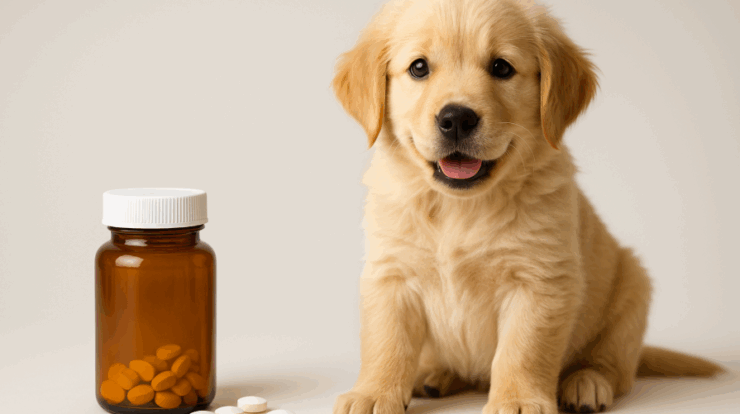What First Causes Dog Paw Swelling?
Even the most watchful pet parent could find dog paw swelling to sneak up on them. Your animal buddy is bounding around the yard one minute; the next, they’re hobbling or incessantly licking at a swollen paw. Especially if you don’t know what caused the swelling, it could be unsettling. Occasionally, it’s as easy as a thorn or insect sting. At other times, it can be a more significant problem such an autoimmune disease, allergic reaction, or infection. The first step in calmly and successfully solving the problem is knowing the possible causes of dog paw swelling.
How to Early Identify Dog Paw Swelling Symptoms
Treatment and recovery can be significantly influenced by early detection of dog paw edema. Watch for alterations in your dog’s gait, too much licking, redness, or heat around the paw area. Swelling could also show as a visibly larger foot pad or between the toes. Sometimes, dog paw swelling will be followed by behavioral indicators such unwillingness to walk or perhaps whimpering. Learning to identify these early signs can enable you to stay one step ahead of any health problems your dog could have.
Dog Paw Swelling Can Be Triggered by Insect Bites and Stings
Dogs, like people, are susceptible to insect bites and stings, particularly during the warmer months. Localised dog paw swelling can be caused by bees, wasps, ants, and even spiders. Inspect your dog carefully if he or she suddenly begins limping or biting at a certain foot. You might find a red, elevated lump or a little puncture wound. Although most insect-related dog paw swelling is moderate and goes away on its own, some dogs may have allergic reactions that call for antihistamines or even veterinarian care.
Foreign Objects Causing Dog Paw Swelling: Glass, Thorns or Other Materials
Our dogs’ unbridled enthusiasm in discovering the world sometimes leads them to tread on things they shouldn’t. Thorns, burrs, and glass shards can lodge themselves in a dog’s paw, causing pain and inflammation. A foreign object can be stuck inside if your dog is favoring one paw or refusing to allow you touch it. Examine the region closely; if you cannot safely remove the item, it is necessary to visit the veterinarian. Removing quickly could help to avoid infection and lessen the severity of dog paw edema.
Dog Paw Swelling from Allergies
Allergies are not only a human issue; they may also harm canines. Pollen, grass, or domestic cleaning chemicals are among environmental allergens that might make your dog’s paws swell. Food allergies could also show up as skin problems including dog paw edema. Allergies could be to blame if you see regular swelling together with itching or redness. To control the underlying problem and lessen symptoms with time, your veterinarian might suggest antihistamines, dietary modifications, or allergy testing.
Infections Causing Swelling of Dog Paws
Persistent dog paw swelling is frequently brought on by infections. Small cuts or punctures in the paw pad allow bacteria or fungus to enter, causing redness, heat, and discharge. A dog with an infected paw could be agitated, lame, or lick too much. Treatment usually consists of cleansing the area, using topical antibiotics, and occasionally administering oral medication. Prompt therapy guarantees the swelling goes down fast and helps to prevent issues.
Swelling of Dog Paws and Interdigital Cysts
Dog paw swelling is also caused by interdigital cysts—those uncomfortable, fluid-filled lumps between your dog’s toes. Irritation, clogged hair follicles, or even bad grooming practices can all contribute to these cysts. Often, they show as red, bloated lumps that untreated could rupture or get infected. Though some cysts go away on their own, some need medical attention. You may control these growths properly by maintaining the afflicted area clean and seeing the vet.
Dog Paw Swelling Caused by Trauma or Injury.
Sometimes running, leaping, and vigorous play cause sprains, fractures, or contusions. Particularly if it’s localized to one paw, trauma is a common cause for unexpected canine paw swelling. Consult a veterinarian if your dog yelps under pressure or won’t carry weight. Depending on the degree of the damage, ice packs, rest, and anti-inflammatory drugs could be recommended.
Autoimmune diseases can cause dog paw swelling.
Autoimmune diseases like lupus or pemphigus could show with symptoms including dog paw edema. These uncommon yet severe illnesses impair a dog’s immune system, therefore attacking its own tissues. Usually, diagnosis consists of skin biopsies and blood tests. Although these diseases are persistent, long-term drugs that lower inflammation and alter immune response can usually help to control them.
Parasites causing dog paw swelling
Mites, ticks, and fleas don’t simply annoy the skin; they can also make dog paw swelling happen. Parasites biting or burrowing into your dog’s paw trigger an immune system response of inflammation and edema. Ticks, especially, can lead to localized reactions. Check your dog’s paws frequently, particularly following outdoor excursions, and apply vet-recommended parasite prophylaxis to keep them away.
Dog Paw Swelling Diagnosis in the Vet
A visit to the doctor is really necessary if dog paw swelling doesn’t go away fast or if it accompanies other symptoms including fever or lethargy. Your veterinarian will look at the paw, question about recent activities, and maybe run blood testing, X-rays, or skin scraping tests. Whether your dog needs medicine, minor surgery, or just a change in routine, accurate diagnosis guarantees he gets the appropriate treatment.
Home Remedies to Soothe Swollen Dog Paws
Home treatments can help with minor dog paw edema. Soaking the paw in warm water with Epsom salts helps to decrease inflammation. Using a cold compress or vet-approved anti-inflammatory might also help to reduce discomfort. These treatments, meanwhile, are better for little problems. The safest course of action is expert treatment if swelling continues or intensifies.
Stopping Dog Paw Swelling Before It Begins
When it comes to dog paw swelling, prevention is the best remedy. Look for cuts, thorns, or symptoms of discomfort on your dog’s paws on a frequent basis. Walks on scorching pavement or treks should include protective booties. Keep your yard clear of hazards and make sure your dog’s grooming habit is current. These little actions help to prevent future painful paw issues quite a lot.
When Dog Paw Swelling Becomes an Urgent Matter
Although many instances of dog paw swelling are insignificant, some call for quick intervention. Seek immediate veterinarian attention if your dog’s paw is very swollen, bleeding, or has a bad odor. Never ignore swelling affecting several paws or followed by systemic signs including vomiting or collapse. When in doubt, trust your gut and move fast.
Controlling Dog Paw Swelling: The Importance of Dieting
A balanced, nutritious diet helps your dog’s immune system and may help to lower inflammation all over the body. Specialized diets or supplements such as omega-3 fatty acids help dogs with allergies or autoimmune disorders. Should you believe your dog’s food is causing paw swelling, talk to your veterinarian about hypoallergenic food options or an elimination diet.
Dealing with Chronic Dog Paw Swelling
Genetics, chronic diseases, or lifestyle choices might cause some dogs to be prone to recurring dog paw swelling. Ongoing management is crucial in these situations. This could involve physical treatment, regular grooming, or perhaps scheduled vet checks. Keeping track of flare-ups in a pet journal might enable you to spot patterns and factors possibly aggravating the problem.
Dog Paw Swelling: Recovery Time and Prognosis
The reason of the dog paw swelling will determine the recovery timeline. While illnesses or injuries could take a week or more to cure, minor problems like insect bites usually go away in a day or two. Most dogs recover completely with quick care and correct treatment. The best result is guaranteed by monitoring progress and following your veterinarian’s recommendations.
Comfort Tips for a Dog with a Swollen Paw
Comfort is essential while your dog is coping with paw swelling. Limit their activity, provide a nice, quiet area for rest, and keep them occupied with mild toys or snacks. Don’t be afraid to contact your veterinarian if you have questions; use prescribed medications regularly. During recuperation, emotional support for your dog is equally as vital as physical care.
Knowing breed tendencies for dog paw swelling
Some breeds are more likely than others to experience paw issues. For instance, bulldogs frequently suffer from interdigital cysts; retrievers could be more prone to allergy reactions. Knowing your dog’s breed-specific hazards enables you to be proactive in reducing dog paw swelling. Discuss with your veterinarian what to look out for and how to best protect your dog’s paws.
Last Thoughts on Dog Paw Swelling Care
A frequent although controllable problem is dog paw edema. Early intervention can prevent complications and help your dog heal more quickly whether the reason is a minor accident, allergies, or something more serious. Regular checkups, a clean environment, and being in tune with your dog’s behavior all help a lot. Your relationship is at the core; your dog relies on you to see when something is amiss and respond. A little information and attention will help you to maintain those paws happy, healthy, and prepared for the next adventure of living.






